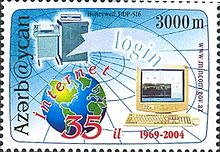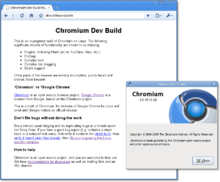Blogger is a blog-publishing service that allows private or multi-user blogs with time-stamped entries. It was developed by Pyra Labs, which was bought by Google in 2003. Generally, the blogs are hosted by Google at a subdomain of blogspot.com. Up until May 1, 2010 Blogger allowed users to publish blogs on other hosts, via FTP. All such blogs had (or still have) to be moved to Google's own servers, with domains other than blogspot.com allowed via custom URLs.[3] Unlike Wordpress, Blogger cannot be installed in a web server. One has to use DNS facilities to redirect a blogspot domain to a custom URL.[4]
History
On August 23, 1999, Blogger was launched by Pyra Labs. As one of the earliest dedicated blog-publishing tools, it is credited for helping popularize the format. In February 2003, Pyra Labs was acquired by Google under undisclosed terms. The acquisition allowed premium features (for which Pyra had charged) to become free. In October 2004, Pyra Labs' co-founder, Evan Williams, left Google. In 2004, Google purchased Picasa; it integrated Picasa and its photo sharing utility Hello into Blogger, allowing users to post photos to their blogs.
On May 9, 2004, Blogger introduced a major redesign, adding features such as web standards-compliant templates, individual archive pages for posts, comments, and posting by email. On August 14, 2006, Blogger launched its latest version in beta, codenamed "Invader", alongside the gold release. This migrated users to Google servers and had some new features, including interface language in French, Italian, German and Spanish.[5] In December 2006, this new version of Blogger was taken out of beta. By May 2007, Blogger had completely moved over to Google operated servers. Blogger was ranked 16 on the list of top 50 domains in terms of number of unique visitors in 2007.
Redesign
As part of the Blogger redesign in 2006, all blogs associated with a user's Google Account were migrated to Google servers. Blogger claims that the service is now more reliable because of the quality of the servers.[7]
Along with the migration to Google servers, several new features were introduced, including label organization, a drag-and-drop template editing interface, reading permissions (to create private blogs) and new Web feed options. Furthermore, blogs are updated dynamically, as opposed to rewriting HTML files.
In a version of the service called Blogger in Draft,[8] new features are tested before being released to all users. New features are discussed in the service's official blog.[9]
Screenshot of blog post compose window of Blogger, April 2012
In September 2009, Google introduced new features into Blogger as part of its tenth anniversary celebration. The features included a new interface for post editing, improved image handling, Raw HTML Conversion, and other Google Docs-based implementations, including:
Adding location to posts via geotagging.
Post time-stamping at publication, not at original creation.
Vertical re-sizing of the post editor. The size is saved in a per-user, per-blog preference.
Link editing in Compose mode.
Full Safari 3 support and fidelity on both Windows and Mac OS.
New Preview dialog that shows posts in a width and font size approximating what is seen in the published view.
Placeholder image for tags so that embeds are movable in Compose mode.
New toolbar with Google aesthetics, faster loading time, and "undo" and "redo" buttons. Also added was the full justification button, a strike-through button, and an expanded color palette.
In 2010, Blogger introduced new templates and redesigned its website. The new post editor was criticized for being less reliable than its predecessor.
Available languages
Blogger is available in these languages: Arabic, Bengali, Indonesia, Bulgarian, Catalan, Chinese (Simplified), Chinese (Traditional), Croatian, Czech, Danish, Dutch, English, Filipino, Finnish, French, German, Greek, Gujarati, Hebrew, Hindi, Hungarian, Indonesian, Italian, Japanese, Kannada, Korean, Latvian, Lithuanian, Malay, Malayalam, Marathi, Norwegian, Oriya, Persian, Polish, Portuguese (Brazil), Portuguese (Portugal), Romanian, Russian, Serbian, Slovak, Slovenian, Spanish, Swedish, Tamil, Telugu, Thai, Turkish, Ukrainian, Vietnamese. Nepali, Farashi
Country specific blogger addresses
Starting in February 2013 Blogger began integrating user blogs with multiple country specific URL addresses i.e. exampleuserblogname.blogspot.com would be automatically redirected to exampleuserblogname.blogspot.ca in Canada, exampleuserblogname.blogspot.co.uk in the United Kingdom etc. Blogger explained that by doing this they could manage the blog content more locally so if there was any objectionable material that violated a particular country's laws they could remove and block access to that blog for that country through the assigned ccTLD while retaining access through other ccTLD addresses and the default BlogSpot.com url. However it should be noted that if a blog using a country specific URL was removed it is still technically possible to still access the blog through Google's No Country Redirect override by entering the URL address using the regular BlogSpot.com address and adding /ncr after the .com
Integration

- The Google Toolbar has a feature called "BlogThis!" which allows toolbar users with Blogger accounts to post links directly to their blogs.
- "Blogger for Word" is an add-in for Microsoft Word which allows users to save a Microsoft Word Document directly to a Blogger blog, as well as edit their posts both on- and offline. As of January 2007, Google says "Blogger for Word is not currently compatible with the new version of Blogger", and they state no decision has been made about supporting it with the new Blogger.[14] However, Microsoft Office 2007 adds native support for a variety of blogging systems, including Blogger.
- Blogger supports Google's AdSense service as a way of generating revenue from running a blog.
- Blogger also started integration with Amazon Associates in December 2009, as a service to generate revenue.[15] It was not publically announced, but by September 2011 it appeared that all integration options had been removed and that the partnership had ended.[16]
- Blogger offers multiple author support, making it possible to establish group blogs.
- Blogger offers a template editing feature, which allows users to customize the Blogger template.
- Windows Live Writer, a standalone app of the Windows Live suite, publishes directly to Blogger.
- Blogger Private Blog features: Blogger offers a private blog that can be only access by author or invited readers /authors or admins only .
- Blogger can be optionally integrated with Google+.
- Google+ comments can be integrated with blogger comments.








